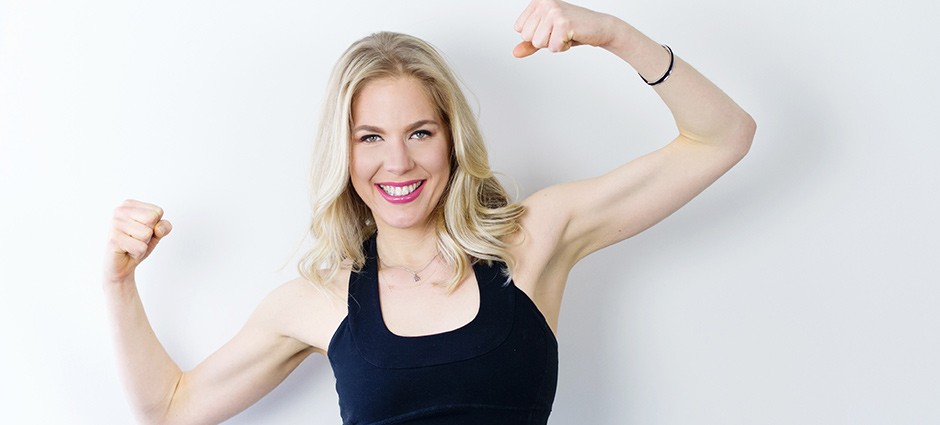Most of us have a vision of who we would like to be—the healthy choices we want to make—and then there’s reality. We want to go to the gym, but we binge-watch Netflix instead. We want to order the salad, but we end up with the burger and fries. Too often, there’s a disconnect between our goals and what we’re doing to achieve them.
If you’re ready to bridge that gap, pick up a copy of Your Fittest Future Self by Kathleen Trotter, a Toronto-based personal trainer, nutritionist, life coach and fitness writer. Equal parts motivational tome and super-practical guide, this book provides the tools you need to, first, cast a realistic vision, and then create an individualized plan—encompassing the three pillars of nutrition, movement and mindset—to make it happen.
Trotter’s voice resonates because she’s been there: She spent the first half of her life unhealthy and unhappy. But one tiny change—a decision to walk 10 minutes a day at lunchtime on the YMCA treadmill—cascaded over time into a fit, balanced and healthy life.
Here, we chat with Trotter about the key components of lasting personal transformation.
Q: You start the book by talking about the importance of “rethinking fit.” What does that mean, and how is it helpful?
A: A lot of us have an unrealistic idea of fitness—maybe to look like the models in Shape magazine. And it’s all or nothing, we think we either need to look like that or there’s no point in trying. But trying to achieve an unrealistic goal is demoralizing. For most people, the tradeoffs required to reach a goal like that wouldn’t make them happy anyway. I encourage people to find a “fit” that makes sense for them individually and then create a real-life, personalized plan to achieve it.
Q: How can the idea of a future self help me in the present?
A: Here’s the key: To create a future self, you have to start now. We get so caught up with finding the perfect day or the perfect week to start our process. We think all our ducks need to be in a row. But the truth with life is: All the ducks will never be in a row. And even if they feel like they’re in a row for like a minute, control is an illusion. I like the image of a big health bucket, and you slowly create positive drops in your bucket. Then, suddenly, you find, “Oh, I feel better; I have more energy.” But those drops start now. This is the only moment you have control over. Ditch the idea of perfection, and just get started.
Q: You talk about the three mixes (individualized plans) of a healthy lifestyle: nutrition, workout and mindset. Is it possible to be healthy without embracing all three?
A: I think I’d rephrase the question, because once you say, “Is it possible to be healthy,” then you’re setting up an all-or-nothing view of health. But health exists on a continuum. You can be slightly healthier by exercising, but not changing your diet, or vice versa. Or maybe you’re watching what you eat and exercising like mad, but your self-talk is terrible and you’re moving toward an eating disorder. You’re going to move farther along the continuum if you embrace all three. That said, I’d rather have someone start with one of the pillars and make even a tiny change than think they have to make big changes in all three areas and never start at all. Because one little change often ends up affecting all the other areas. Maybe you say, “The only thing I’m going to do is drink more water.” OK, great. If you drink more water, that could start a domino effect: It’s going to make you feel more full, so maybe you’re going to eat a little less, which will make you feel a bit more energized. That might make you feel happier during the day, so you’ll go on a walk at lunch.
Q: So where do you start?
A: Start with what you can manage. Don’t be afraid to set the bar low enough to where you can actually succeed. But if you want faster change, identify a habit with the biggest ripple effect. Maybe you usually eat well during the day, but at 10 o’clock at night, you’re exhausted, but you don’t want to go to bed so you eat an extra 1,000 calories from 10 p.m. to 1 a.m. If that’s you, then tweaking what you eat for breakfast or doing an extra 10 minutes on the treadmill isn’t going to make much difference. Instead, say to yourself: “Between 8 p.m. and 8 a.m., no food—nonnegotiable.” Figure out where you could use the most work, and change that. Don’t mow the lawn when your house is on fire.
Q: How can this book help the person who has tried everything, without lasting change? How is this book different?
A: That person probably falls into one of two categories. The first is someone who thinks they’ve tried everything, but in reality, they’ve spent a lot of time thinking about their health or planning to change things without actually doing much. The second is someone who has tried to follow someone else’s perfect plan but hasn’t tailored it to what’s realistic for them personally. This book help you discover that individualized plan and create a mindset and internal dialogue that enables you to follow it.

